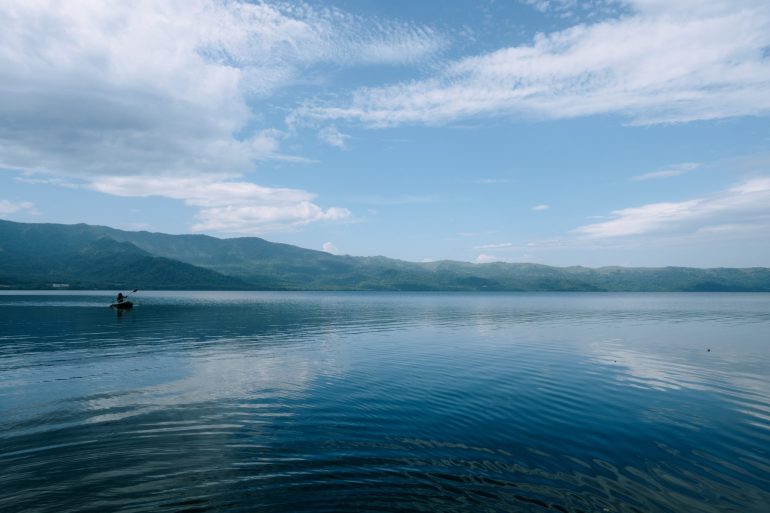There’s a huge variety of lakes in Japan, from large and deep crater lakes to small and shallow mountain lakes. Each lake has its own unique beauty, and they all offer different opportunities for exploration and recreation.
This article explores the largest lakes of Japan by surface area, looking at aspects such as how they were formed, their aquatic life and how they’re used today. We’re starting with Japan’s biggest lake.
Biwa

Lake Biwa (Photo: B. Tanaka via Getty Images)
Japan’s biggest lake is larger than the US city of Chicago and shaped like the short-necked lute from which it gets its name. Located just northeast of Kyoto, Lake Biwa has a surface area of 259 square miles. Formed as a result of tectonic activity, a lake has been present at the site for around a million years, making Biwa one of the oldest lakes in the world.
Around 2,300 aquatic and semi aquatic species have been detected in or around Lake Biwa. Of these, up to 146 are endemic. In other words, they are found only there. Today, Biwa is registered by UNESCO as a wetland of international importance. As well as being an important commercial fishing site, it’s a popular place for boating and recreational fishing and supplies water to approximately 14 million people.
Kasumigaura

Sunset over Lake Kasumigaura (Photo: rockptarmigan via Getty Images)
Just under 40 miles northwest of Tokyo is Japan’s second largest lake, Kasumigaura. Covering some 85 square miles, Kasumigaura is in fact made up of three adjoined lakes, Nishiura, Kitaura and Sotonasakaura. Of these, Nishiura is considered the main lake, its surface area being around 65 square miles.
Connected to the Pacific Ocean until 1963, Kasumigaura was originally a mix of salt and freshwater, but is now only the latter. Much like Biwa, Kasumigaura is a vital source of domestic water to surrounding areas. However, it is most important as a provider of irrigation for nearby agricultural land. A visit to Kasumigaura would include seeing the many tourists and fishing enthusiasts who frequent this most popular of lakes near Tokyo.
Saroma

Autumn sky and Lake Saroma (Photo: makafushigi via Getty Images)
It may be shallow, but Lake Saroma or ‘Saroma-Ko’ is the third of the largest lakes of Japan, its surface area covering approximately 59 square miles. It is one of several lakes protected within the Abashiri-Quasi National Park in Hokkaidō, Japan’s second largest island.
Inawashiro

Lake Inawashiro (Photo: Serizawa via Getty Images)
Found in Bandai-Asahi National Park in Fukushima Prefecture, Lake Inawashiro or ‘Inawashiro-ko’ has a surface area of 40 square miles, making it the fourth-largest lake in Japan. The eruption of Mount Bandai, which is to the north, played a role in forming Inawashiro around 30,000 – 40,000 years ago.
Back then, it was a tectonic depression, but the gases and volcanic matter from the eruption created a dam. Inawashiro is commonly known as Tenkyōko, meaning ‘Heavenly Mirror Lake’, for its incredibly clear waters.
Naka-umi

Lake Nakaumi from Hill Park ( Photo: thanyarat07 via Getty Images)
Fifth in line of the largest lakes in Japan is Naka-umi, with its surface area of roughly 33 square miles. Straddling the prefectures of Tottori and Shimane, its mix of freshwater and seawater classifies it as a ‘brackish’ lake. It is this, and its connection to the Sea of Japan, that some attribute as the reason behind its name, which means ‘middle sea’.
Nakaumi is home to two islands, Eshima and Daikon. It is also connected to Japan’s seventh biggest lake, Shinji.
Kussharo

Calm waters at Lake Kussharo (Photo: Ippei Naoi via Getty Images)
The surface area of Lake Kussharo is around 31 square miles, landing it at number six on this list of the largest lakes in Japan. Like many Japanese lakes, Kussharo-ko was created by volcanic activity and even has a volcanic cone, Nakajima, peeking out at its centre. It is found on the eastern end of Hokkaidō, in Akan National Park.
Shinji

The sun sets on Lake Shinji (Photo: KAZUHIRO NOGI via Getty Images)
There’s barely a difference in size between the seventh and eighth largest lakes of Japan, but Lake Shinji just loses out on the seventh spot with its surface area of just under 31 square miles. Known as Shinji-ko, the sister lake of Naka-umi offers a winter haven for up to 48,000 water birds every year and 80 different brackish aquatic species.
The Famous Lakes of Japan

Sailboats on Lake Kasumigaura (Photo: gyro via Getty Images)
And so ends our tour of the best-known lakes in Japan. We’ve explored the largest lakes of Japan, covering both the most famous lakes near Tokyo and those all around the country.











